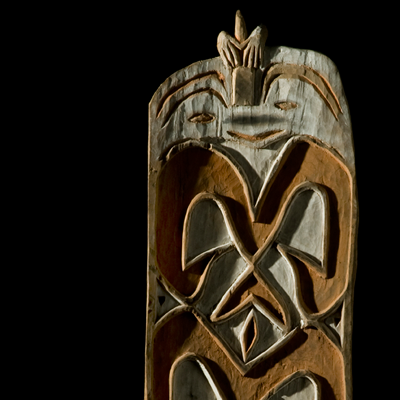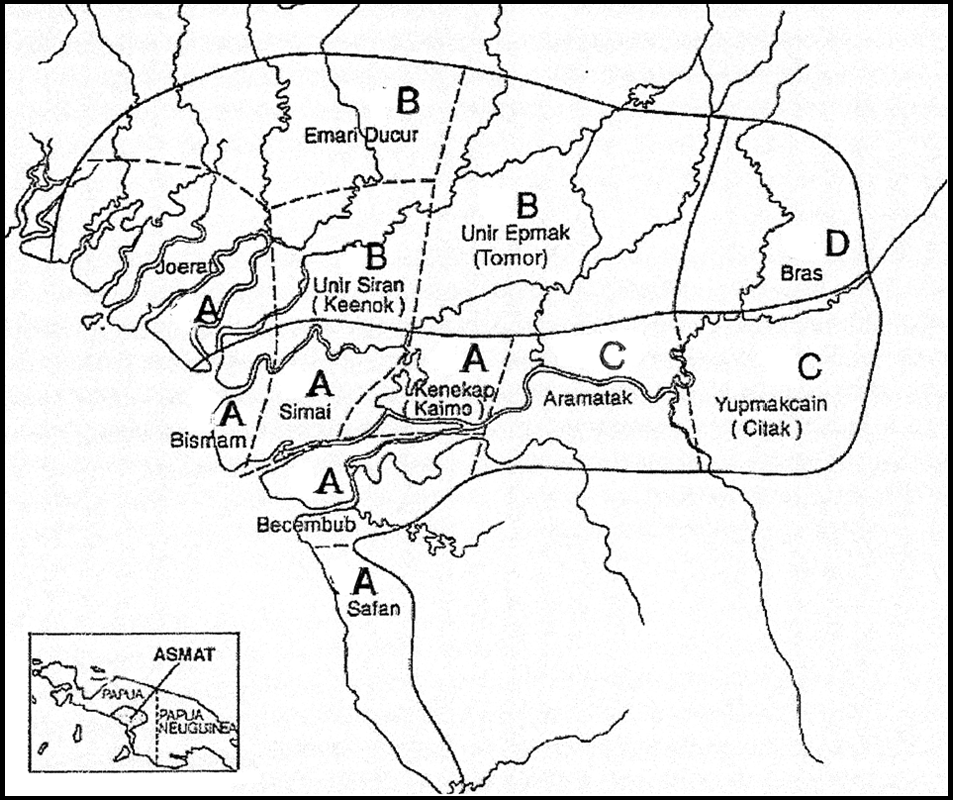|
|
The Shields
The Asmat warrior treasures his shield as his most powerful weapon. This object, with engraved symbols of the protective spirits, embodies the warrior himself. He will never forsake it and will pass it on only to a direct offspring. The shield is never destroyed, even if the warrior dies and in this case the head of the shield is cut off. (see picture)
The shields are not merely powerful war tools, they represent a protection against evil spirits and ghosts through the iconography of the ancestors. They are placed inside the house near the entrance or laid transversally on the ground, to allow the spirits to protect the house during the owner’s absence. In the occasion of feasts and ritual ceremonies, the shields are grouped together, to cumulate their energy and inspire courage, enduring strength and dexterity.
The shields are divided in four stylistic areas (see picture of map) each characterized by a unique type of decoration, form, design or motive peculiar to the area. In the coastal villages, the carvers use softwood, usually mangrove, while in the interior a harder wood is utilized. The shields may reach a height ranging from 1,70 to 2,00 metres. In the past the carver used tools made of stone, bone and shell. Today metal tools are more frequent.
|


|
The shields found on the coast and in the central part of the region (area A) are rectangular, with a human figure as a representation of the ancestral spirit on top. This phallic projection is called the cemen (phallus) of the shield.
The shields originating in the villages of the northwest (area B) are larger and oval; the top part is separate and more clearly defined, usually representing a manta, a stingray, a turtle or a casuarius. Taken as a whole, the shield has a phallic form.
Citak or Kaunak shields (area C) are the most impressive in size. The top is slightly rounded and resembles an abstract human head. The base is flat.
Brazza River shields (area D) are similar to those produced in the Citak area, with a slightly different top part, which is sharply pointed, with a painted nose and spiral shaped eyes, resembling the ancestor to whom the shield is dedicated.
The central body is engraved and painted with typical headhunting symbols, which can differ according to the area. The boldest designs are found along the coast, in the south (area A), similar to shell nose ornaments which refer to wild boar tusks. Usually it is combined or interspered with the ainor symbol, the meaning of which is so terrible that the enemy is paralysed: enormous dilated pupils with the form of two connected spirals. The shields of the northwest (area B) are smaller with very intricate designs and totemic symbols such as the flying fox, its legs, cuscus tails, whirlpools and wild boar bones. The Citak popolations (area C) have a very dense and repeated design, which symbolizes the water leaking out of the sago drain. There is very few information regarding other Citak designs and even fewer related to the Brazza River populations (area D).
The designs reproduced on the shields confer to the owner all the necessary characteristics to coexist with the world of the spirits, based on the relation he has with his own shield. The first and most important function is to appease all the spirits who live in the forest and in the rivers.
|
|
|